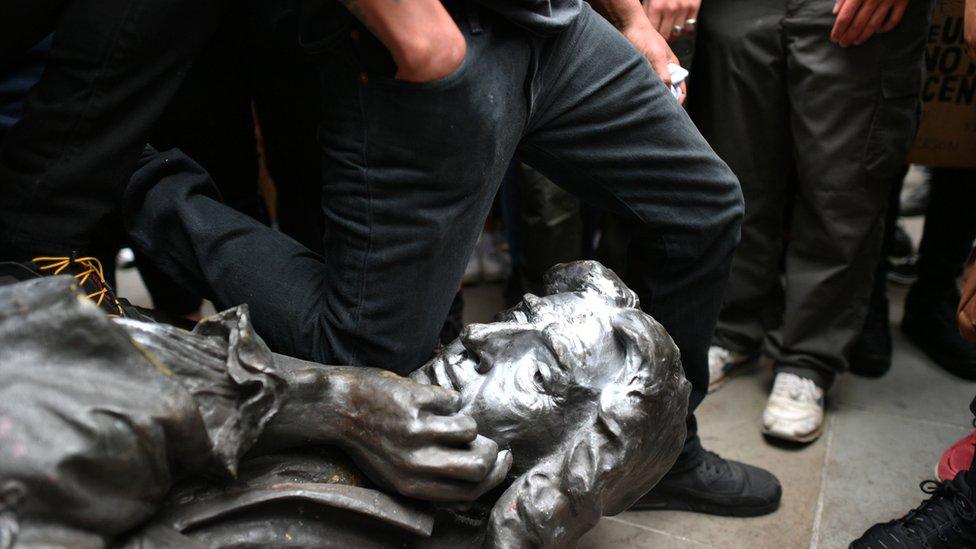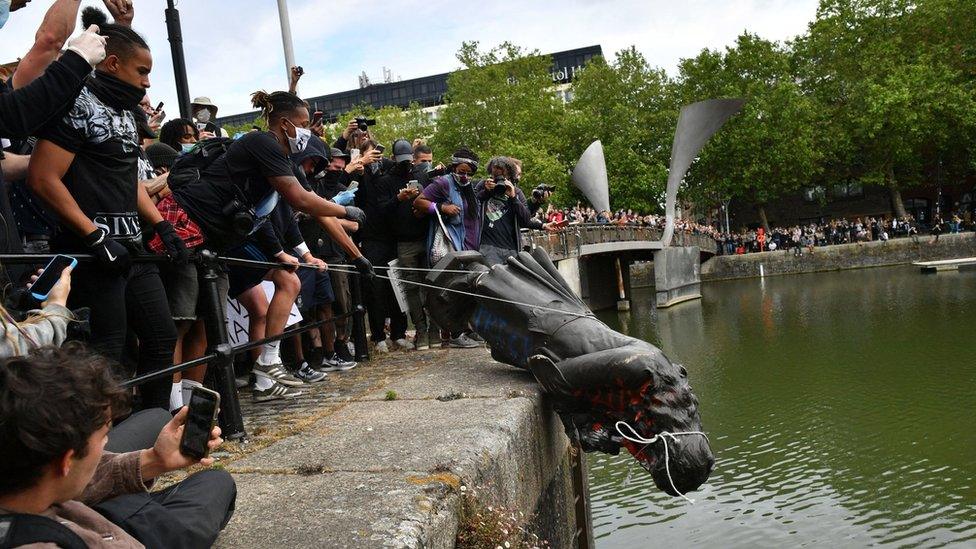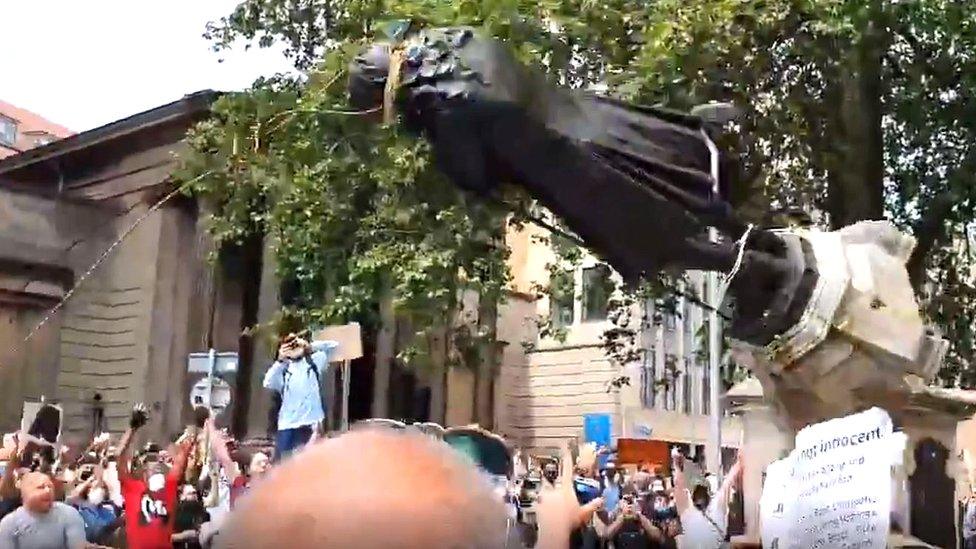Racism and statues: How the toxic legacy of empire still affects us
- Published
BBC News presenter Clive Myrie visits Bristol and explores its colonial legacy
There is no shortage of websites that, for the right fee, will help you trace your ancestry. Some even offer step-by-step instructions on how to complete a DNA test to pinpoint the global region you may belong to.
Just pop a small sample of saliva into a container in a prepaid envelope, send it off to be analysed against hundreds of thousands of genetic markers, and a couple of months later, voila.
I know I'm Afro-Caribbean, born in Bolton to parents who came to the UK from Jamaica in the 1960s.
I know my grandmother on my mum's side spent a few years in Panama as a child, when her father, my great-grandad, worked on the building of the Panama Canal.
Beyond that, I have no clue who I am.
That's because, like virtually all British West Indians, my lineage extends back to Africa and the transatlantic slave trade.
I know I'm likely to have come from somewhere in West Africa, but which country? I haven't the foggiest.
Does this matter to me? Yes, it does. We all want to feel rooted with a clear connection to the past.
Deep roots help steady us, give us confidence, hold us upright. When those roots aren't there, when the branches of the family tree are broken, there's a sadness and a sense you're almost floating through life, untethered to the ground.
This is one of the toxic legacies of empire, and part of the debate currently raging about the veneration of men - and they're overwhelmingly men - whose likenesses in statues dot the British landscape in towns and city centres.
These are people whose lives and achievements were - shall we say - complicated, and the people who raised the money to erect their statues chose to focus on the "good" they did in life, not the bad.
Take Edward Colston, 17th Century Bristol merchant and deputy governor of the Royal African Company, which held a monopoly on the English trade in African slaves.
He made a fortune out of human bondage, but you wouldn't know it to read the words at the base of his statue in Bristol city centre - "Erected by citizens of Bristol as a memorial of one of the most virtuous and wise sons… AD 1895."
On the west-facing relief, Colston is depicted dispensing charity to poor children; on the north he is shown at the harbour; on the east is a scene with marine horses, mermaids, and anchors.
But nowhere to be seen is any depiction of the more than 80,000 slaves he helped to put in chains and send to the plantations of the British Caribbean territories - that's if they managed to survive the terrible Atlantic voyage at all.

The people who erected Colston's statue in the late 19th Century decided their version of this man's history was more palatable and more valid. It was his philanthropy that won the day, not his slave trading.
But a new generation isn't willing to absolve Colston any longer.
His statue was pulled down by a large crowd of people in front of the world's media, and now an updated city-wide school curriculum for primary and secondary pupils is due to come into force in Bristol in September.
That curriculum will provide a more comprehensive analysis of Bristol's role in the Atlantic slave trade, and context for the life of men like Edward Colston.

A protester kneels on the neck of the bronze statue of Colston
Asha Craig is the deputy mayor of Bristol and the descendant of Jamaican immigrants. She's one of the driving forces behind the new curriculum and she told me it had been a key objective of councillors to look at the legacy of the city, because we all have to know our own history.
"Education," she says, "is what will help eliminate racism."
Children need to understand early on that history has many perspectives, that memory can be multidimensional.
Yes, the UK had a great empire, but there was a dark side to that supremacy, and racism was the rocket fuel of conquest.
In the weeks since the death of George Floyd at the hands of Minneapolis police, there has been a global soul-searching over racism and its causes.
There has been much discussion of the "othering" of individuals and whole peoples, and how to tackle discrimination and unequal treatment of some in society.
Greater knowledge and awareness of history is a good first step.
The protesters in Bristol, after pulling down the statue of Edward Colston, dragged him through the city centre and dumped him in the harbour, near where his ships set sail for West Africa with goods that would be traded for slaves.

I managed to track down where the statue eventually ended up, in a warehouse covered in mud after having been fished from the water.
Council conservation workers are now trying to preserve the various pieces of graffiti that the protesters spray-painted on Colston in red.
I peered down on Colston's oversized face and reflected on the irony of me, a second-generation immigrant of Jamaican parents, now looking down on the man who may even have helped ship my ancestors into slavery, having branded into their backs the letters RAC - for Royal African Company.
He was beneath my gaze, not the other way round.
At some point, he'll be placed back on his plinth, probably in a museum with a plaque outlining not just his philanthropy, but also his slave trading.
A reminder that, ultimately, history and memory belong to us all, not just the victors.

Read more stories about the legacies of British colonial rule and how it is still affecting people today:
- Published8 June 2020
